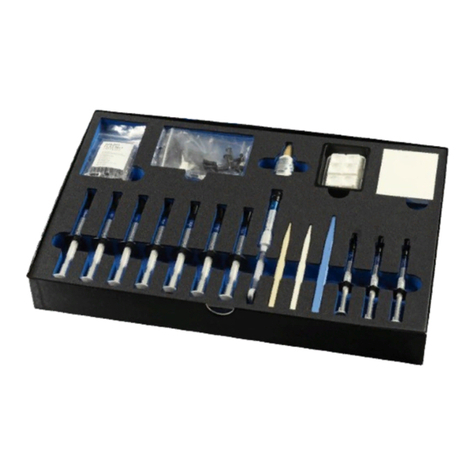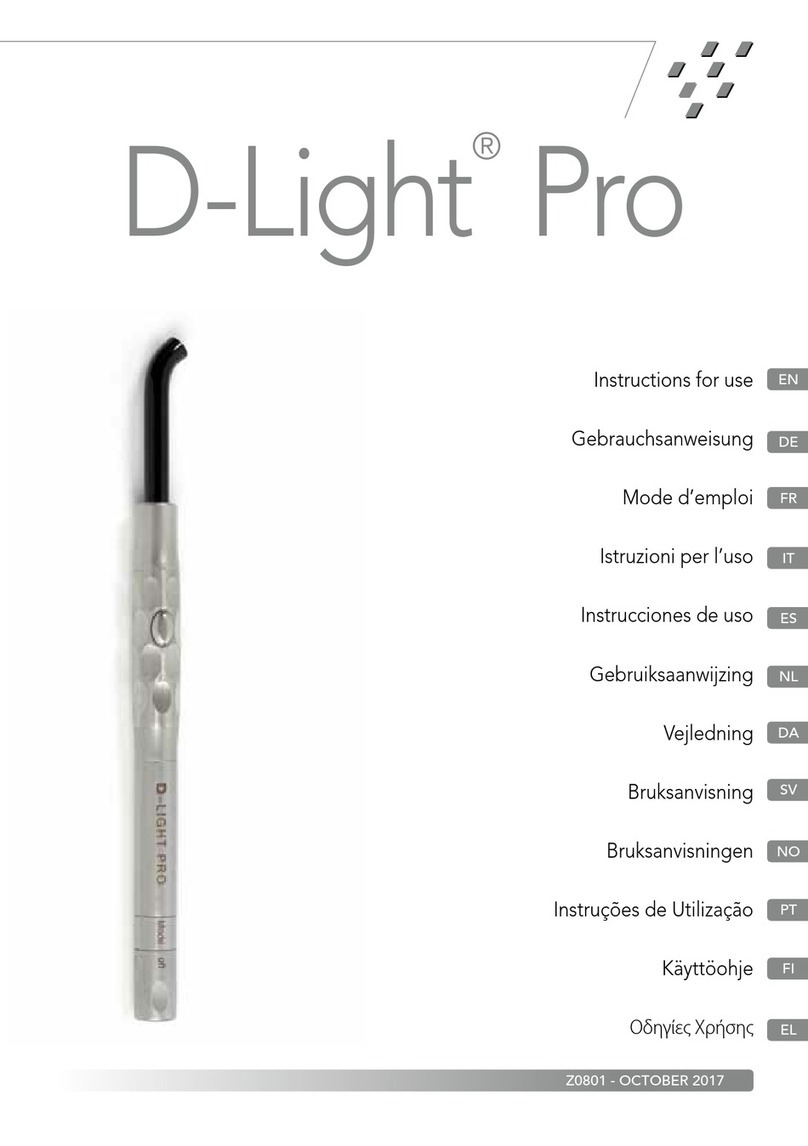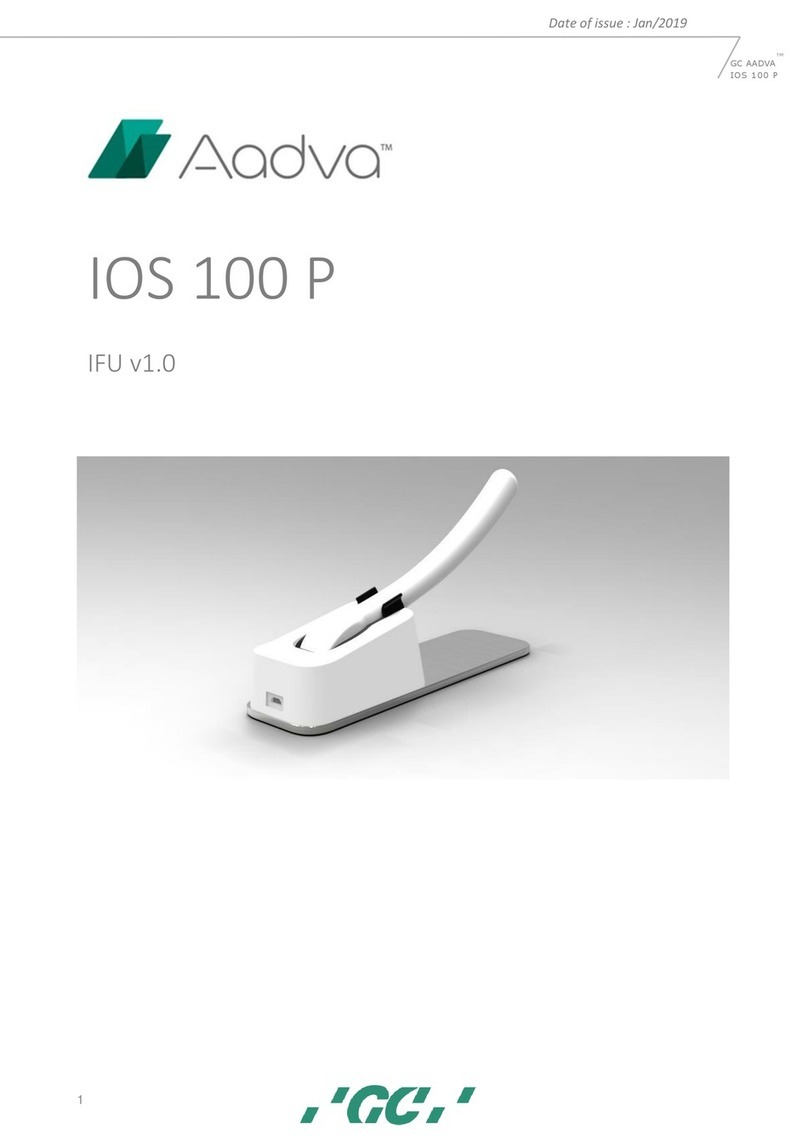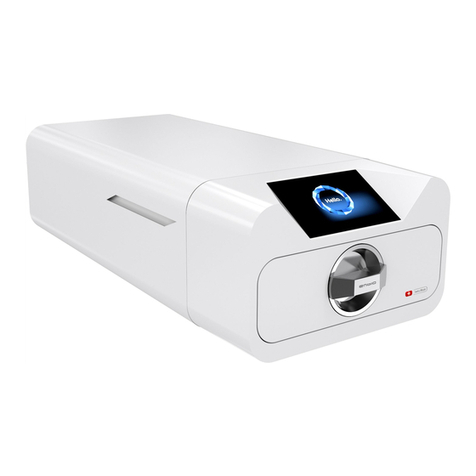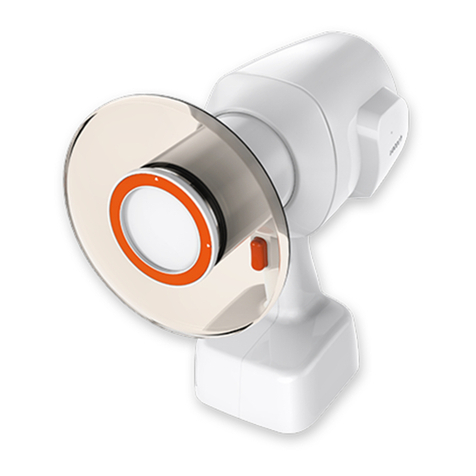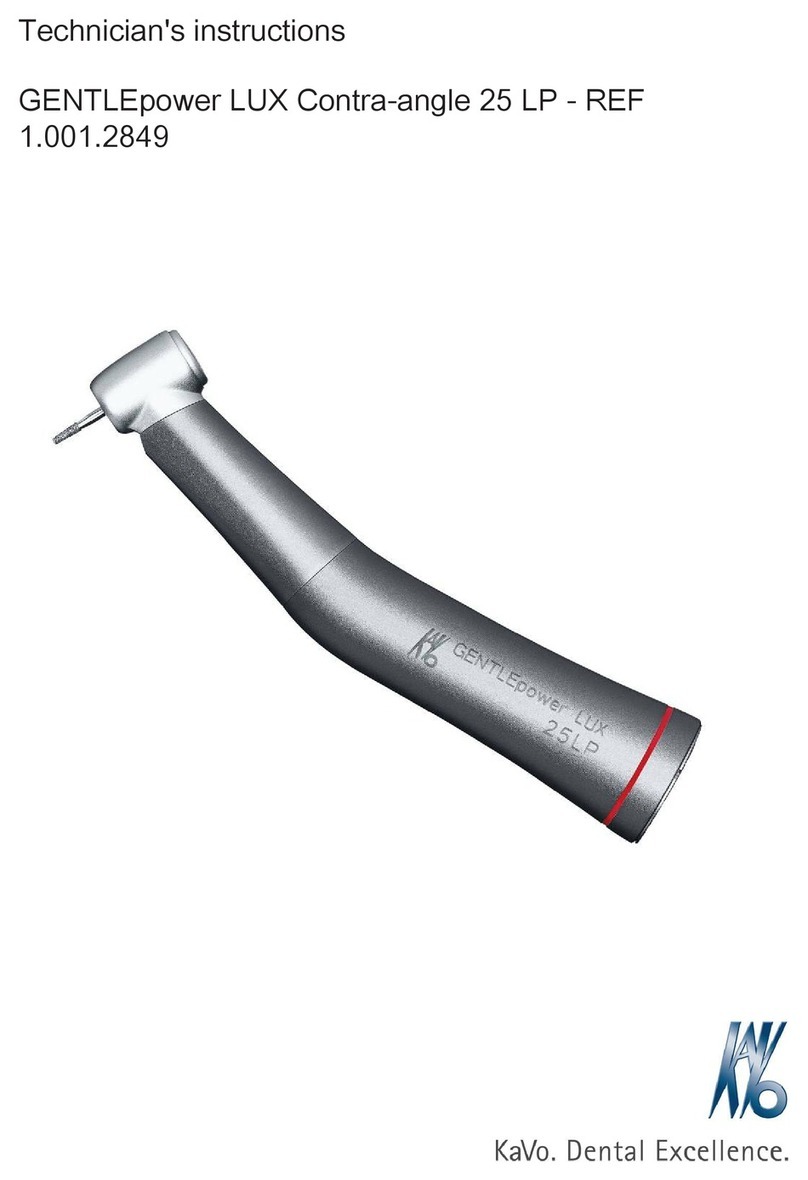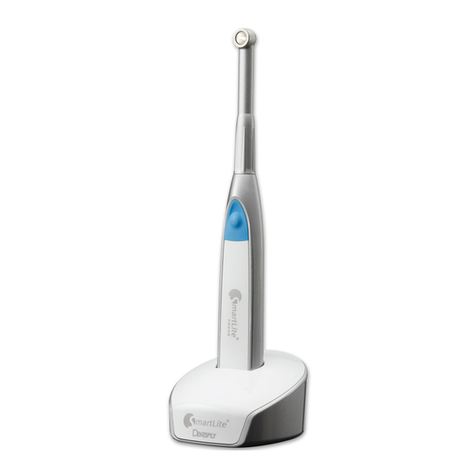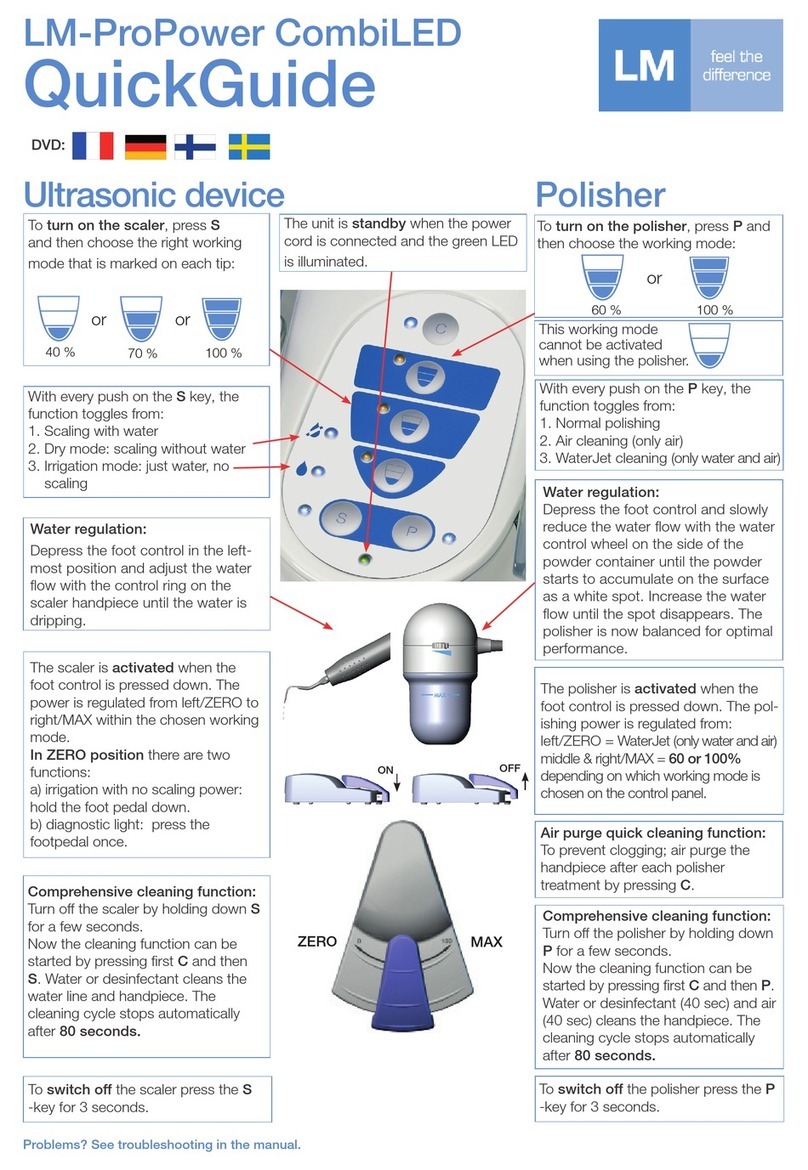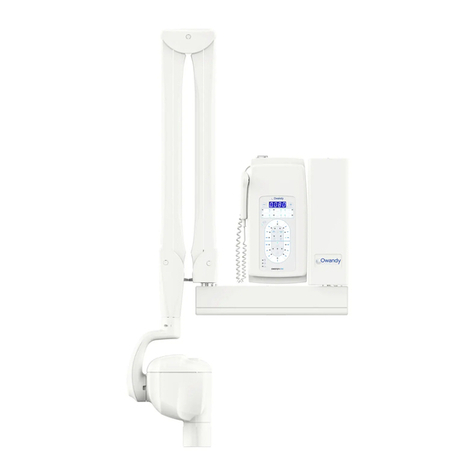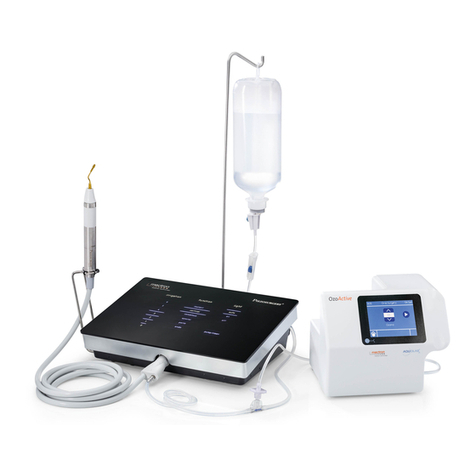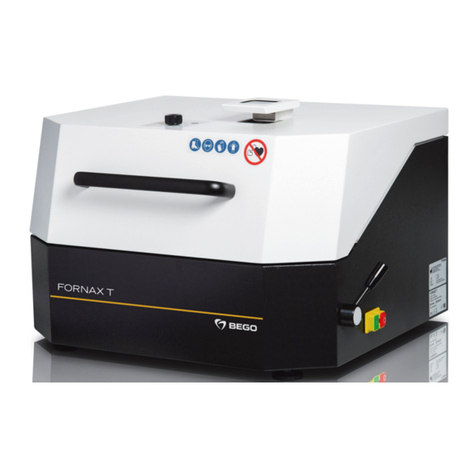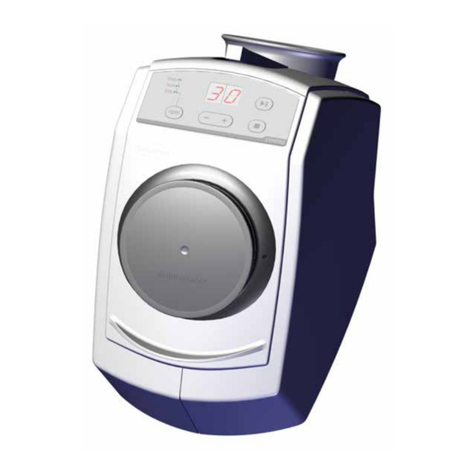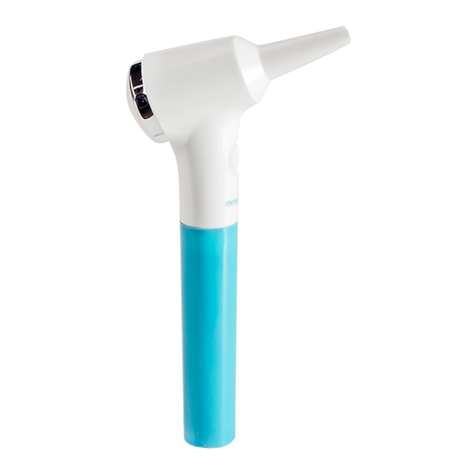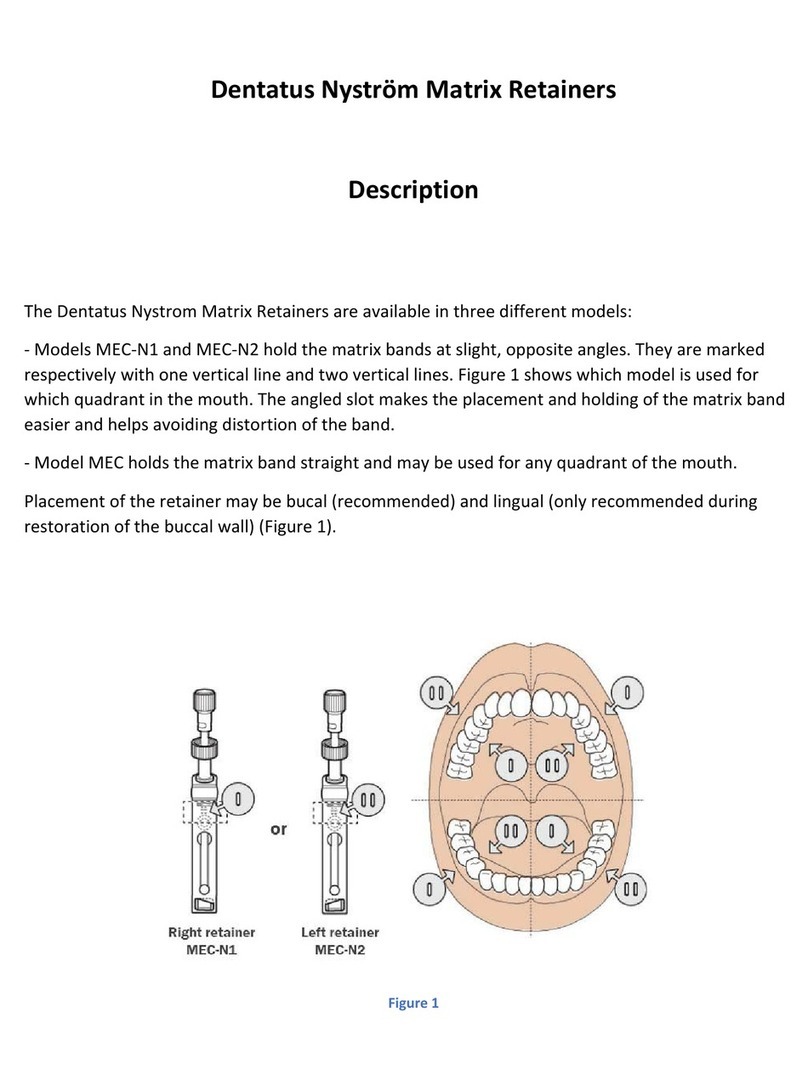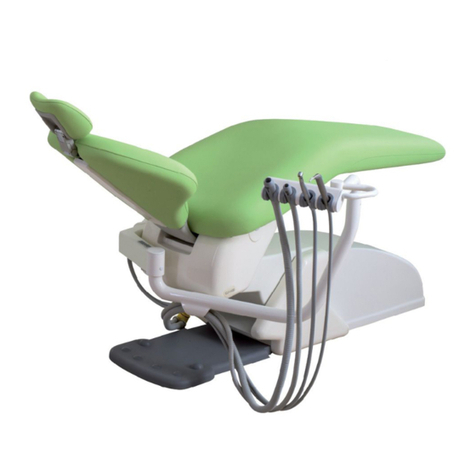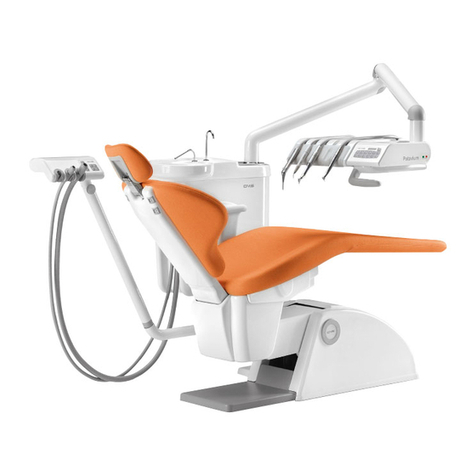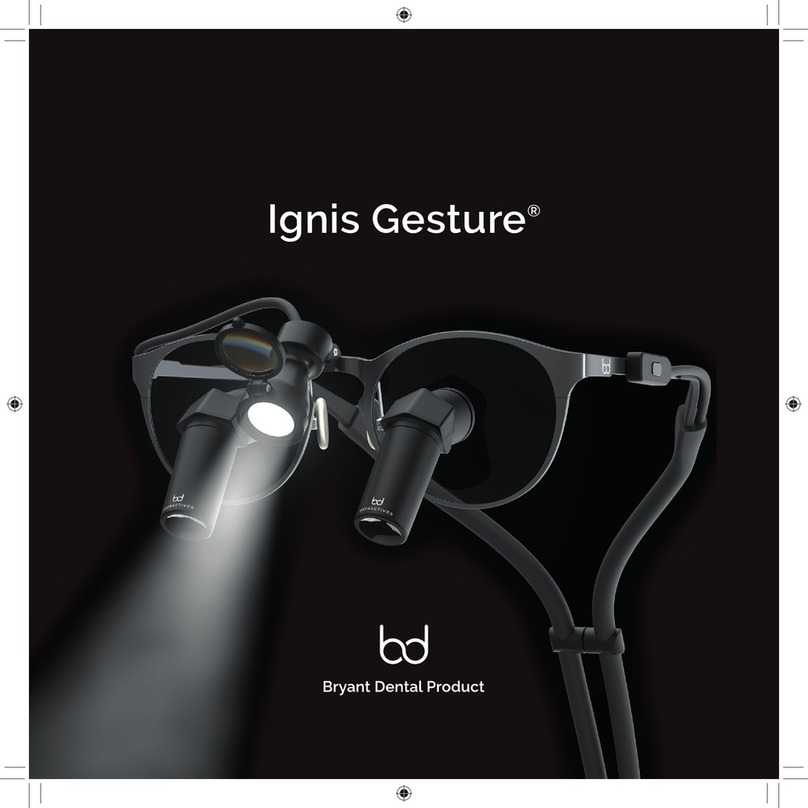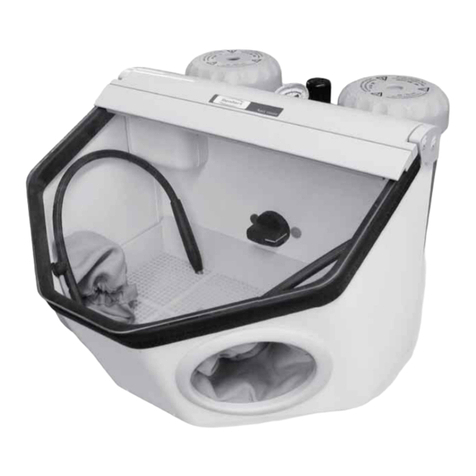gc D-Light Pro User manual

EN
BG
CS
HR
HU
PL
RO
RU
SK
SL
SR
UK
TR
LV
LT
ET
Instructions for use
Инструкции за употреба
Návod k použití
Upute za uporabu
Használati útmutató
Instrukcja użytkowania
Instrucţiuni de folosire
Инструкция по применению
Návod na použitie
Navodila za uporabo
Uputstvo za upotrebu
Iнструкція з експлуатації
Kullanma kılavuzu
Lietošanas instrukciju
Naudojimo instrukcijos
Kasutusjuhend
Z0900 - SEPTEMBER 2016
D-Light
®
Pro
406950-GC-D-LIGHT DUO-IFU-OOST ok.indd 1 13/10/16 15:57

2
1. SAFETY INSTRUCTIONS
• The unit should only be used by a qualified dental
professional.
• Be sure to follow the instructions in order to use the unit
correctly and to safeguard the patient and user.
• Patients as well as dental professionals should always use
appropriate safety precautions. Use the D-Light Pro curing
light with great care and carefully comply with all safety
precautions, including wearing suitable light filtering
safety glasses or goggles for the operator, assistant and
patient.
• For working with the unit, the owner must provide the
person(s) with the written operating instructions in an
understandable format as well as in the relevant
language(s). The owner is fully responsible to assure that
the D-Light Pro unit is in a safe working condition at all
times. If in doubt, do not use the unit and contact the
supplier.
• Prior to use, make sure that the unit is working normally
and safely. It should also be checked on a regular basis.
• Keep the unit out of the reach of infants or children.
• Do not use the unit on patients with a history of eye
disease such as cataract or retinal problems. This may
cause eye damage.
• The unit must not be disassembled or remodeled. This
may cause the unit to leak, generate heat, ignite or
explode.
• Only authorized technicians can repair the D-Light Pro
curing light, battery packs and charging station.
• Use of accessories not mentioned in this manual may
result in unsafe conditions and/or reduced product
performance. For this reason, use only factory authorized
accessories.
• The unit should not be handled with wet (gloved) hands.
This may cause a breakdown.
• The unit should not be exposed to direct sunlight, dust, a
wet environment or placed near a heater.
CONTENTS
1. Safety instructions
2. Features
3. Indications
4. Identification of parts
5. Setup
6. Operation
7. Autoclaving and care of the unit
8. Troubleshooting
9. Disposal
10. Warranty & Repair
11. Packaging
12. Equipment class
13. Specifications
14. Explanation of Symbols and Storage
15. Contact Information
16. EMC Tables
• Make certain there is a match between incoming power
supply and the product electrical requirement. Do not use
the recharger with voltages different than stated in this
manual or labeled on the equipment.
• Do not touch the inside of the battery compartment or
the contact points of the battery charger directly with the
hands or any metal objects. This may cause a breakdown.
• The battery should not be thrown into a fire or heated. It
should not be struck with a sharp object or with force,
disassembled or remodeled. This may cause the battery to
leak, generate heat, ignite or explode.
• Do not allow the battery contact points to touch other
metal objects. Do not carry or store the battery next to
metal objects in order to avoid accidental contact with the
battery contact points.
• Do not charge, use or leave the battery in high
temperatures, near fire or in direct sunlight, etc.
• Store the unit away from flammable materials.
• If the lithium-polymer battery should leak, do not touch
the liquid. In case of skin contact, flush immediately with
tap water because the liquid may be corrosive and cause
skin irritation or damage.
• If any liquid leaks from the battery and comes into contact
with the eyes, do not rub. Flush immediately with tap
water and seek medical attention. The liquid may cause
eye irritation or damage.
• Voltage is present in the charging station and battery
packs: do not open! Operate only in dry conditions. Never
manipulate with wet hands as this may cause an electrical
shock.
• If the battery or unit should begin to smoke, emit a bad
odour, deform or discolor during irradiation, charging or
storage, then discontinue usage immediately. Continued
usage may cause the battery to leak, and/or the unit to
generate heat, ignite or explode.
• Avoid sudden or strong impacts to the handpiece. This
may cause a breakdown or a reduction in the amount of
light emitted.
• Do not use mobile phones or other hand-held electronic
devices at the same time as the D-Light Pro.
• The light guide and eye-protection shield (either hard or
soft version) should be attached correctly in order to
ensure that they do not become detached during use.
Check routinely. Should they become loose or cracked,
then discontinue their use to avoid hazards such as
swallowing or inhalation. Make sure to fix the eye-
protection shield correctly.
• If the light guide should crack or break, immediately
discontinue use. The light guide is made of glass and there
is a possibility of fragments accidentally being displaced
into the mouth.
• Do not look directly into the light emitted through the
light guide. This may cause eye damage. Prior to use, be
sure to fix the eye-protection shield (either hard or soft
version).
• Prolonged usage of any curing light can increase
temperature. Extended usage near pulp and soft tissues
should be avoided to prevent injury. Curing near or around
sensitive tissues should be performed in short time
DLIGHT® PRO
DUAL WAVELENGTH LED CURING LIGHT
intervals. The Low Power mode (LP) can also be used to
limit heat generation when close to the pulp.
• If the handpiece is not used for an extended period of
time, or the unit is being transported, then the battery
should be removed from the handpiece or charging
station.
• Maintain adequate infection control measures when using
the D-Light Pro in the oral cavity, and execute the
appropriate hygiene plan after usage with patients.
• Protect the D-Light Pro from contamination by using
protective plastic barrier-sleeves. These sleeves are
intended for single-use; discard after each patient to
prevent possible cross-contamination. Protective plastic
barrier-sleeves are not needed when the light-guide and
handpiece sleeve are autoclaved between each patient.
• When using protective plastic barriers (bags, shields, etc.)
with the D-Light Pro, be certain that these are securely
affix to avoid patient aspiration and treatment
complications.
• Do not use the Detection mode (DT) in conjunction with
caries detection dyes.
• Do not use if you have red-green color blindness or visual
impairment.
2. FEATURES
• LED powered visible light curing and visualisation unit
with high power output
• The D-Light Pro can polymerize light cured dental
materials, quickly and efficiently.
• The D-Light Pro contains two different types of LEDs
with different wavelength peaks. This enables the
D-Light Pro to activate commonly used photo initiators
used in dentistry, like Camphorquinone (wavelength
peak of 468 nm) used in most light-cured materials, and
other initiators (wavelength peak of 400 +1-20 nm)
used in some light-cured dental materials.
• The D-Light Pro Detection mode (DT) assists the
visualisation of bacteria in plaque and carious lesions
and the identification of fluorescent materials.
• The D-Light Pro offers an easy-to-use and elegant
stainless steel design. The design ensures a
user-friendly operation of the unit.
• Lithium polymer batteries, when fully charged, allow
for more than 45 individual irradiations of 20 seconds
duration each. The lithium polymer battery has no
memory effect, and a fast recharging speed of 75
minutes.
• The D-Light Pro is designed to offer a stable and
continuous high light output over several years.
• Built-in radiometer
• In addition to the light guide, the handpiece is
autoclavable once the internal electronic module and
battery pack have been removed.
• The D-Light Pro is under warranty for a period of 3
years, except the battery (1 year warranty) and
consumables (no warranty).
3. INDICATIONS
• Polymerisation of visible light curing materials curing
with a wavelength range of 400 to 480nm. In case of
questions about the wavelength ranges for certain
materials, please contact their respective
manufacturers.
• The Detection mode (DT) assists the visualization of
bacteria in plaque, fissures, infected dentin and the
presence of micro-leakage. It also helps to identify
fluorescent restorative materials, and to evaluate the
depth of cracks in the tooth structure.
4. IDENTIFICATION OF PARTS
• Handpiece Figure 1
• Electronic module Figure 2
• Battery packs (x2) Figure 3
• Light-guide Figure 4
• Soft eye-protector shields (x3) Figure 5
• Hard, oval eye-protection shield Figure 5
• Charging station Figure 6
• Power supply and cable Figure 6
• EU/UK plug adapters Figure 7
5. SETUP
• Carefully unpack all D-Light Pro components and
familiarize yourself with the individual items. Check for
completeness.
• First, check that the voltage indicated on the D-Light Pro
charging station name plate complies with the local
power supply.
Battery
• Prior to initial use or use after a long interval of non-use,
be sure to charge or recharge the batteries completely.
Use the original charging station and lithium polymer
battery only. Do not use any other battery chargers or
batteries.
• Connect the power cord to the charging station, and the
plug of the power cord to the mains power outlet
(110-240V AC) (Figure 8)
• Insert the batteries fully onto the docking ports of the
charging station until you hear/feel a ‘click’ (Figure 9)
• There is a LED corresponding to each docking port.
When the LED is illuminated, the battery is in the process
of being charged. When the LED turns off, then charging
is completed. Two batteries can be simultaneously
charged.
• Do not connect the depleted battery pack to the
charging station until it is properly cleaned and
disinfected.
• The time to fully charge an empty battery is
approximately 75 minutes.
• When the D-Light Pro is not in use for a prolonged
period of time, the battery pack should be disconnected
from the handpiece; or the handpiece/battery should be
in the “off” position.
• Batteries may be stored on the docking ports of the
charging station as long as there is power to the
charging station.
EN
DE
FR
IT
ES
NL
DA
SV
NO
PT
FI
EL
406950-GC-D-LIGHT DUO-IFU-OOST ok.indd 2 13/10/16 15:57

3
D-Light®Pro
1. SAFETY INSTRUCTIONS
• The unit should only be used by a qualified dental
professional.
• Be sure to follow the instructions in order to use the unit
correctly and to safeguard the patient and user.
• Patients as well as dental professionals should always use
appropriate safety precautions. Use the D-Light Pro curing
light with great care and carefully comply with all safety
precautions, including wearing suitable light filtering
safety glasses or goggles for the operator, assistant and
patient.
• For working with the unit, the owner must provide the
person(s) with the written operating instructions in an
understandable format as well as in the relevant
language(s). The owner is fully responsible to assure that
the D-Light Pro unit is in a safe working condition at all
times. If in doubt, do not use the unit and contact the
supplier.
• Prior to use, make sure that the unit is working normally
and safely. It should also be checked on a regular basis.
• Keep the unit out of the reach of infants or children.
• Do not use the unit on patients with a history of eye
disease such as cataract or retinal problems. This may
cause eye damage.
• The unit must not be disassembled or remodeled. This
may cause the unit to leak, generate heat, ignite or
explode.
• Only authorized technicians can repair the D-Light Pro
curing light, battery packs and charging station.
• Use of accessories not mentioned in this manual may
result in unsafe conditions and/or reduced product
performance. For this reason, use only factory authorized
accessories.
• The unit should not be handled with wet (gloved) hands.
This may cause a breakdown.
• The unit should not be exposed to direct sunlight, dust, a
wet environment or placed near a heater.
CONTENTS
1. Safety instructions
2. Features
3. Indications
4. Identification of parts
5. Setup
6. Operation
7. Autoclaving and care of the unit
8. Troubleshooting
9. Disposal
10. Warranty & Repair
11. Packaging
12. Equipment class
13. Specifications
14. Explanation of Symbols and Storage
15. Contact Information
16. EMC Tables
• Make certain there is a match between incoming power
supply and the product electrical requirement. Do not use
the recharger with voltages different than stated in this
manual or labeled on the equipment.
• Do not touch the inside of the battery compartment or
the contact points of the battery charger directly with the
hands or any metal objects. This may cause a breakdown.
• The battery should not be thrown into a fire or heated. It
should not be struck with a sharp object or with force,
disassembled or remodeled. This may cause the battery to
leak, generate heat, ignite or explode.
• Do not allow the battery contact points to touch other
metal objects. Do not carry or store the battery next to
metal objects in order to avoid accidental contact with the
battery contact points.
• Do not charge, use or leave the battery in high
temperatures, near fire or in direct sunlight, etc.
• Store the unit away from flammable materials.
• If the lithium-polymer battery should leak, do not touch
the liquid. In case of skin contact, flush immediately with
tap water because the liquid may be corrosive and cause
skin irritation or damage.
• If any liquid leaks from the battery and comes into contact
with the eyes, do not rub. Flush immediately with tap
water and seek medical attention. The liquid may cause
eye irritation or damage.
• Voltage is present in the charging station and battery
packs: do not open! Operate only in dry conditions. Never
manipulate with wet hands as this may cause an electrical
shock.
• If the battery or unit should begin to smoke, emit a bad
odour, deform or discolor during irradiation, charging or
storage, then discontinue usage immediately. Continued
usage may cause the battery to leak, and/or the unit to
generate heat, ignite or explode.
• Avoid sudden or strong impacts to the handpiece. This
may cause a breakdown or a reduction in the amount of
light emitted.
• Do not use mobile phones or other hand-held electronic
devices at the same time as the D-Light Pro.
• The light guide and eye-protection shield (either hard or
soft version) should be attached correctly in order to
ensure that they do not become detached during use.
Check routinely. Should they become loose or cracked,
then discontinue their use to avoid hazards such as
swallowing or inhalation. Make sure to fix the eye-
protection shield correctly.
• If the light guide should crack or break, immediately
discontinue use. The light guide is made of glass and there
is a possibility of fragments accidentally being displaced
into the mouth.
• Do not look directly into the light emitted through the
light guide. This may cause eye damage. Prior to use, be
sure to fix the eye-protection shield (either hard or soft
version).
• Prolonged usage of any curing light can increase
temperature. Extended usage near pulp and soft tissues
should be avoided to prevent injury. Curing near or around
sensitive tissues should be performed in short time
DLIGHT® PRO
DUAL WAVELENGTH LED CURING LIGHT
intervals. The Low Power mode (LP) can also be used to
limit heat generation when close to the pulp.
• If the handpiece is not used for an extended period of
time, or the unit is being transported, then the battery
should be removed from the handpiece or charging
station.
• Maintain adequate infection control measures when using
the D-Light Pro in the oral cavity, and execute the
appropriate hygiene plan after usage with patients.
• Protect the D-Light Pro from contamination by using
protective plastic barrier-sleeves. These sleeves are
intended for single-use; discard after each patient to
prevent possible cross-contamination. Protective plastic
barrier-sleeves are not needed when the light-guide and
handpiece sleeve are autoclaved between each patient.
• When using protective plastic barriers (bags, shields, etc.)
with the D-Light Pro, be certain that these are securely
affix to avoid patient aspiration and treatment
complications.
• Do not use the Detection mode (DT) in conjunction with
caries detection dyes.
• Do not use if you have red-green color blindness or visual
impairment.
2. FEATURES
• LED powered visible light curing and visualisation unit
with high power output
• The D-Light Pro can polymerize light cured dental
materials, quickly and efficiently.
• The D-Light Pro contains two different types of LEDs
with different wavelength peaks. This enables the
D-Light Pro to activate commonly used photo initiators
used in dentistry, like Camphorquinone (wavelength
peak of 468 nm) used in most light-cured materials, and
other initiators (wavelength peak of 400 +1-20 nm)
used in some light-cured dental materials.
• The D-Light Pro Detection mode (DT) assists the
visualisation of bacteria in plaque and carious lesions
and the identification of fluorescent materials.
• The D-Light Pro offers an easy-to-use and elegant
stainless steel design. The design ensures a
user-friendly operation of the unit.
• Lithium polymer batteries, when fully charged, allow
for more than 45 individual irradiations of 20 seconds
duration each. The lithium polymer battery has no
memory effect, and a fast recharging speed of 75
minutes.
• The D-Light Pro is designed to offer a stable and
continuous high light output over several years.
• Built-in radiometer
• In addition to the light guide, the handpiece is
autoclavable once the internal electronic module and
battery pack have been removed.
• The D-Light Pro is under warranty for a period of 3
years, except the battery (1 year warranty) and
consumables (no warranty).
3. INDICATIONS
• Polymerisation of visible light curing materials curing
with a wavelength range of 400 to 480nm. In case of
questions about the wavelength ranges for certain
materials, please contact their respective
manufacturers.
• The Detection mode (DT) assists the visualization of
bacteria in plaque, fissures, infected dentin and the
presence of micro-leakage. It also helps to identify
fluorescent restorative materials, and to evaluate the
depth of cracks in the tooth structure.
4. IDENTIFICATION OF PARTS
• Handpiece Figure 1
• Electronic module Figure 2
• Battery packs (x2) Figure 3
• Light-guide Figure 4
• Soft eye-protector shields (x3) Figure 5
• Hard, oval eye-protection shield Figure 5
• Charging station Figure 6
• Power supply and cable Figure 6
• EU/UK plug adapters Figure 7
5. SETUP
• Carefully unpack all D-Light Pro components and
familiarize yourself with the individual items. Check for
completeness.
• First, check that the voltage indicated on the D-Light Pro
charging station name plate complies with the local
power supply.
Battery
• Prior to initial use or use after a long interval of non-use,
be sure to charge or recharge the batteries completely.
Use the original charging station and lithium polymer
battery only. Do not use any other battery chargers or
batteries.
• Connect the power cord to the charging station, and the
plug of the power cord to the mains power outlet
(110-240V AC) (Figure 8)
• Insert the batteries fully onto the docking ports of the
charging station until you hear/feel a ‘click’ (Figure 9)
• There is a LED corresponding to each docking port.
When the LED is illuminated, the battery is in the process
of being charged. When the LED turns off, then charging
is completed. Two batteries can be simultaneously
charged.
• Do not connect the depleted battery pack to the
charging station until it is properly cleaned and
disinfected.
• The time to fully charge an empty battery is
approximately 75 minutes.
• When the D-Light Pro is not in use for a prolonged
period of time, the battery pack should be disconnected
from the handpiece; or the handpiece/battery should be
in the “off” position.
• Batteries may be stored on the docking ports of the
charging station as long as there is power to the
charging station.
EN
DE
FR
IT
ES
NL
DA
SV
NO
PT
FI
EL
EN
BG
CS
HR
HU
PL
RO
RU
SK
SL
SR
UK
TR
LV
LT
ET
406950-GC-D-LIGHT DUO-IFU-OOST ok.indd 3 13/10/16 15:57

4
Handpiece
• First, insert the electronic module into the handpiece
(Figure 10).
• Next, insert the battery into the rear end of the
handpiece/electronic module assembly (Figure 11).
Light-guide
• Before each use, autoclave the light guide and
handpiece.
CAUTION! Be certain to remove the electronic module
and battery pack from the handpiece.
• Disinfect the eye-protection shield.
• Insert the light guide into the handpiece (Figure 12).
Make sure that the light guide snaps into position.
Mount either the hard or soft eye-protection shield on
the light guide.
• NOTE: For the Detection mode (DT), the use of the hard
eye-protection shield is recommended for improved
visibility.
6. OPERATION
Activating the unit
• Gently insert one battery pack into the rear-end of the
D-Light Pro handpiece after the electronic module is
inserted. You will feel the connector guide the battery
automatically into the “Off position”.
• When resistance is felt, gently push the battery all the
way into the handle. A click will be heard when the
battery pack is completely inserted and correctly
seated in the D-Light Pro handpiece (Figure 11).
• Rotate the cap of battery pack by quarter turns in either
direction, to select the required curing program (Figure
13).
• Adjust the angle of the light if necessary by “rolling”
your pen-like grip.
• Press the start button (Figure 14). Keep the tip of the
light guide as close as possible to the surface of the
material to be cured. Prevent direct contact with the
material. In case of contact, carefully remove remaining
material from the light guide using a plastic spatula.
• The D-Light Pro handpiece may feel slightly warm
during prolonged operation. This is normal.
Curing programs
PROGRAM FEATURES
HP
High Power
Standard curing with dual wavelength featuring a 20 second cycle with high output power (approx.
1400 mW/cm2) for maximum efficiency.
LP
Low Power
Low power curing with dual wavelength featuring a 20 second cycle with approx. 700 mW/cm2
output, optimal for instance when curing close to the pulp.
DT
Detection
Violet light only featuring a 60 second cycle, for the visualization of fluorescent restorative materials
and/or identification of bacteria in plaque, fissures, infected dentin, etc. (see Indications).
Tone signals
TONE SIGNAL EXPLANATION
1x A curing cycle has started or ended.
1 Quick Tone and
a Flash 10 seconds of curing have been completed.
2x A curing cycle has been interrupted prematurely.
3x The internal temperature of the handpiece is too high. After 3 minutes pause, the curing light can be
used again.
4x Too many consecutive curing cycles have been performed (>10), and a short pause is required
(maximum 3 minutes)
5x Battery charge is low. The battery needs recharging.
Quick Tone(s) Selection of a new program (Battery cap rotation)
HP=1 quick tone; LP= 2 quick tones; DT= 3 quick tones
Radiometer Usage
• Select the High Power (HP) curing program
• To confirm proper light output, cover the window of
the built-in radiometer in the charging station with
the light-guide and press the start button (Figure 15).
• The green LED response means the light output is
sufficient for usage.
• The red LED response means that the light output is
not sufficient for curing. Check troubleshooting
section before contacting technical support.
7. AUTOCLAVING AND CARE OF THE UNIT
• The light guide and handpiece sleeve can be steam-
autoclaved at 134°C (275°F) maximum (Figure 16).
CAUTION! Prior to autoclaving, remove the electronic
module and battery pack from the handpiece by pulling
on the “Mode” ring.
• Clean and sterilize the light guide and handpiece in a
sterilization bag before each patient application.
• Use a validated sterilization process at a maximum
temperature of 134°C and for a time of up to 20 min.
Perform sterilization according to EN 17665-1:2006 and EN
556-1:2001 at 134 °C for at least 3 minutes and use steam
sterilizers that comply with the requirements of EN
13060:2004+A2:2010, class B or S.
• The eye-protection shields (soft and hard versions) cannot
be autoclaved, but should be disinfected using an alcohol-
based disinfectant.
• Remove the battery pack prior to routine cleaning,
disinfection and maintenance of the unit.
• The docking ports of the charging station can be cleaned
with a dry clean brush.
• The charging station, battery, and eye-protection shield
should be cleaned with a soft cloth moistened with
alcohol. Organic detergents such as thinners or petroleum
benzine should not be used. Take care not to get water
inside the charging station or on the contact points of the
battery.
8. TROUBLESHOOTING
If any difficulty is experienced while operating the unit,
please check below for possible causes of the problem
and suggested corrective actions before seeking further
advice or repair from your point of purchase.
Problem Check Corrective Action
When the start button is
pressed, the light will not
come on.
Is the battery discharged or the charging
status extremely low? Charge the battery.
Is the battery set correctly in the
handpiece/electronic module assembly?
If not, reset the battery in the right position
(refer to section “activating the unit”).
Is the electronic module correctly inserted
into the handpiece?
Remove the electronic module and insert it
again into the handpiece
Has an extended period of continuous
irradiation been carried out?
The unit is cooling down. After a minimum a
3 minutes where the device is not in use, it can
be started again.
The battery cannot be
charged.
Is the charging station correctly
connected?
Check to ensure the charging station is
correctly connected to the power supply.
Check if the power supply is correctly
connected to the mains.
Is the battery firmly set in the charging
station?
Remove any dust present in the docking ports
of the charging station and insert the battery
firmly in the docking port.
Is the battery already completely charged? Insert the battery into the handpiece and activate
to confirm the battery has a charge.
The unit is working normally,
but the material will not
cure.
Is the shelf life of the material expired? Use fresh material.
Has the light guide been damaged? Clean or replace the light guide.
The light guide or electronic
module is difficult to insert
Is the groove of the light guide or
electronic module clean and free from
damage?
Apply a small amount of lubricant on the groove
of the light guide or electronic module
The radiometer indicates a
red light response
Has the light guide been damaged? Clean or replace the light guide.
Is the window of the radiometer free of any
material? Clean the radiometer window.
EN
DE
FR
IT
ES
NL
DA
SV
NO
PT
FI
EL
406950-GC-D-LIGHT DUO-IFU-OOST ok.indd 4 13/10/16 15:57

5
D-Light®Pro
Handpiece
• First, insert the electronic module into the handpiece
(Figure 10).
• Next, insert the battery into the rear end of the
handpiece/electronic module assembly (Figure 11).
Light-guide
• Before each use, autoclave the light guide and
handpiece.
CAUTION! Be certain to remove the electronic module
and battery pack from the handpiece.
• Disinfect the eye-protection shield.
• Insert the light guide into the handpiece (Figure 12).
Make sure that the light guide snaps into position.
Mount either the hard or soft eye-protection shield on
the light guide.
• NOTE: For the Detection mode (DT), the use of the hard
eye-protection shield is recommended for improved
visibility.
6. OPERATION
Activating the unit
• Gently insert one battery pack into the rear-end of the
D-Light Pro handpiece after the electronic module is
inserted. You will feel the connector guide the battery
automatically into the “Off position”.
• When resistance is felt, gently push the battery all the
way into the handle. A click will be heard when the
battery pack is completely inserted and correctly
seated in the D-Light Pro handpiece (Figure 11).
• Rotate the cap of battery pack by quarter turns in either
direction, to select the required curing program (Figure
13).
• Adjust the angle of the light if necessary by “rolling”
your pen-like grip.
• Press the start button (Figure 14). Keep the tip of the
light guide as close as possible to the surface of the
material to be cured. Prevent direct contact with the
material. In case of contact, carefully remove remaining
material from the light guide using a plastic spatula.
• The D-Light Pro handpiece may feel slightly warm
during prolonged operation. This is normal.
Curing programs
PROGRAM FEATURES
HP
High Power
Standard curing with dual wavelength featuring a 20 second cycle with high output power (approx.
1400 mW/cm2) for maximum efficiency.
LP
Low Power
Low power curing with dual wavelength featuring a 20 second cycle with approx. 700 mW/cm2
output, optimal for instance when curing close to the pulp.
DT
Detection
Violet light only featuring a 60 second cycle, for the visualization of fluorescent restorative materials
and/or identification of bacteria in plaque, fissures, infected dentin, etc. (see Indications).
Tone signals
TONE SIGNAL EXPLANATION
1x A curing cycle has started or ended.
1 Quick Tone and
a Flash 10 seconds of curing have been completed.
2x A curing cycle has been interrupted prematurely.
3x The internal temperature of the handpiece is too high. After 3 minutes pause, the curing light can be
used again.
4x Too many consecutive curing cycles have been performed (>10), and a short pause is required
(maximum 3 minutes)
5x Battery charge is low. The battery needs recharging.
Quick Tone(s) Selection of a new program (Battery cap rotation)
HP=1 quick tone; LP= 2 quick tones; DT= 3 quick tones
Radiometer Usage
• Select the High Power (HP) curing program
• To confirm proper light output, cover the window of
the built-in radiometer in the charging station with
the light-guide and press the start button (Figure 15).
• The green LED response means the light output is
sufficient for usage.
• The red LED response means that the light output is
not sufficient for curing. Check troubleshooting
section before contacting technical support.
7. AUTOCLAVING AND CARE OF THE UNIT
• The light guide and handpiece sleeve can be steam-
autoclaved at 134°C (275°F) maximum (Figure 16).
CAUTION! Prior to autoclaving, remove the electronic
module and battery pack from the handpiece by pulling
on the “Mode” ring.
• Clean and sterilize the light guide and handpiece in a
sterilization bag before each patient application.
• Use a validated sterilization process at a maximum
temperature of 134°C and for a time of up to 20 min.
Perform sterilization according to EN 17665-1:2006 and EN
556-1:2001 at 134 °C for at least 3 minutes and use steam
sterilizers that comply with the requirements of EN
13060:2004+A2:2010, class B or S.
• The eye-protection shields (soft and hard versions) cannot
be autoclaved, but should be disinfected using an alcohol-
based disinfectant.
• Remove the battery pack prior to routine cleaning,
disinfection and maintenance of the unit.
• The docking ports of the charging station can be cleaned
with a dry clean brush.
• The charging station, battery, and eye-protection shield
should be cleaned with a soft cloth moistened with
alcohol. Organic detergents such as thinners or petroleum
benzine should not be used. Take care not to get water
inside the charging station or on the contact points of the
battery.
8. TROUBLESHOOTING
If any difficulty is experienced while operating the unit,
please check below for possible causes of the problem
and suggested corrective actions before seeking further
advice or repair from your point of purchase.
Problem Check Corrective Action
When the start button is
pressed, the light will not
come on.
Is the battery discharged or the charging
status extremely low? Charge the battery.
Is the battery set correctly in the
handpiece/electronic module assembly?
If not, reset the battery in the right position
(refer to section “activating the unit”).
Is the electronic module correctly inserted
into the handpiece?
Remove the electronic module and insert it
again into the handpiece
Has an extended period of continuous
irradiation been carried out?
The unit is cooling down. After a minimum a
3 minutes where the device is not in use, it can
be started again.
The battery cannot be
charged.
Is the charging station correctly
connected?
Check to ensure the charging station is
correctly connected to the power supply.
Check if the power supply is correctly
connected to the mains.
Is the battery firmly set in the charging
station?
Remove any dust present in the docking ports
of the charging station and insert the battery
firmly in the docking port.
Is the battery already completely charged? Insert the battery into the handpiece and activate
to confirm the battery has a charge.
The unit is working normally,
but the material will not
cure.
Is the shelf life of the material expired? Use fresh material.
Has the light guide been damaged? Clean or replace the light guide.
The light guide or electronic
module is difficult to insert
Is the groove of the light guide or
electronic module clean and free from
damage?
Apply a small amount of lubricant on the groove
of the light guide or electronic module
The radiometer indicates a
red light response
Has the light guide been damaged? Clean or replace the light guide.
Is the window of the radiometer free of any
material? Clean the radiometer window.
EN
DE
FR
IT
ES
NL
DA
SV
NO
PT
FI
EL
EN
BG
CS
HR
HU
PL
RO
RU
SK
SL
SR
UK
TR
LV
LT
ET
406950-GC-D-LIGHT DUO-IFU-OOST ok.indd 5 13/10/16 15:57
Other manuals for D-Light Pro
1
Table of contents
Languages:
Other gc Dental Equipment manuals
